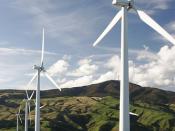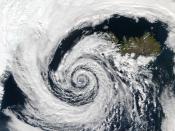Wind is the roughly horizontal movement of air (as opposed to an air current) caused by uneven heating of the Earth's surface. It occurs at all scales, from local breezes generated by heating of land surfaces and lasting tens of minutes to global winds resulting from solar heating of the Earth. The two major influences on the atmospheric circulation are the differential heating between the equator and the poles, and the rotation of the planet (Coriolis effect). Given a difference in barometric pressure between two air masses, a wind will arise between the two which tends to flow from the area of high pressure to the area of low pressure until the two air masses are at the same pressure, although these flows will be modified by the Coriolis effect in the extratropics. Winds can be classified either by their scale, the kinds of forces which cause them (according to the atmospheric equations of motion), or the geographic regions in which they exist.
There are global winds, such as the wind belts which exist between the atmospheric circulation cells. There are upper-level winds, such as the jet streams. There are synoptic-scale winds that result from pressure differences in surface air masses in the middle latitudes, and there are winds that come about as a consequence of geographic features such as the sea breeze. Mesoscale winds are those which act on a local scale, such as gust fronts. At the smallest scale are the microscale winds which blow on a scale of only tens to hundreds of metres and are essentially unpredictable, such as dust devils and microbursts. Winds can also shape landforms, via a variety of eolian processes. Eolian (or aeolian) processes pertain to the activity of the winds. Winds may erode, transport, and deposit materials, and are...


